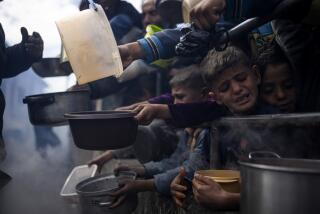Poverty : Ranks of Poor Still Swelling Worldwide Despite Evidence of Economic Growth
- Share via
UNITED NATIONS — Whether Communist or capitalist, military or civilian, single-party state or democracy, most countries of the developing world have one thing in common--growing, festering numbers of poor.
In a special United Nations survey, Secretary General Javier Perez de Cuellar reported recently that 1.1 billion people live in poverty in the Third World, more than half of them “extremely poor.” In addition, the industrialized world, including Eastern Europe, has 200 million poor people.
Asia has the most people classified extremely poor--400 million who live in heavily populated areas like the Ganges plains of India, the Delta of Bangladesh and the island of Java in Indonesia, according to the survey. Another 120 million extremely poor people live in the rural areas of Africa and another 50 million in the Andean highlands and urban slums of Latin America.
Even Third World countries with healthy rates of economic growth often have intractable problems of poverty. This plight of the poor amid plenty is fashioned by overpopulation, lack of education, inequitable distribution of wealth and World Bank and International Monetary Fund policies that may prove a boon in the long run but add to the rolls of the poor in the meantime.
In recent months economists have been hailing the health of the economies of Latin American countries such as Venezuela, Mexico and Chile that have grown from 4% to 10% in the last year, stellar performances in this era of a lackluster worldwide economy.
But none of this growth has diminished the numbers of poor people.
Many of the reforms imposed on developing countries by international agencies and Western governments do not seem very healthy in the short run.
These reforms, which economists call “structural adjustment,” require developing governments to balance their budgets by removing subsidies that keep the prices of food and other products low, selling state enterprises that have huge wage bills but few profits, and reducing the size of the bureaucracy.
Structural adjustment is powered by the belief that prosperity demands a free-market economy. Countries undertaking these reforms are more attractive to foreign aid donors, outside investors and native entrepreneurs, but these reforms also cut jobs and raise prices in the cities.
Irving Leonard Markovitz, an Africa specialist and professor of political science at the City University of New York, has studied the growing class of entrepreneurs in Senegal for 25 years. They are an economic success story. In the first years of independence in the 1960s, Senegalese leaders preached “African socialism.” But now, Markovitz says, “everybody preaches and practices capitalism and does so naturally, without any thought that this might be something extraordinary or in need of justification.”
Although some of the Senegalese entrepreneurs have deposited their profits in Swiss bank accounts, a growing number are reinvesting their profits into productive enterprises in the small, sophisticated but underdeveloped country in West Africa.
Yet, in the face of this growth, Markovitz says, “poverty has been increasing in Senegal just like everywhere else. The people are more and more desperate. A long-range type of development is going on. But it is classic capitalist development, which is not a very pretty picture.”
In the U.N. report, Perez de Cuellar suggested that structural reforms should be accompanied by other international programs that:
* Reduce the Third World’s debt to banks and governments.
* Eliminate the tariffs of industrialized countries that block imports from the developing countries.
* Increase foreign aid to the developing countries.
* Encourage family planning.
* Employ the latest technology to increase food production.
Where People Are Living in Poverty
Percentage of population in poverty in selected countries in 1988: South Korea: 16% Malaysia: 27% Thailand: 30% Paraguay: 35% Ecuador: 51% Philippines: 58% Nicaragua: 20% El Salvador: 27% Botswana: 51% Indonesia: 39% Guatemala: 71% Morocco: 37% Kenya: 44% Pakistan: 30% India: 48% Haiti: 76% Bangladesh: 86% Ethiopia: 64% Source: United Nations Development Program
Poverty in the Developing World
Region Number of Poor % of Population Sub-Saharan Africa 180 million 47% East Asia 280 million 20% South Asia 520 million 51% Middle East, N. Africa 60 million 31% Latin America 70 million 19%
Source: World Bank
More to Read
Sign up for Essential California
The most important California stories and recommendations in your inbox every morning.
You may occasionally receive promotional content from the Los Angeles Times.










